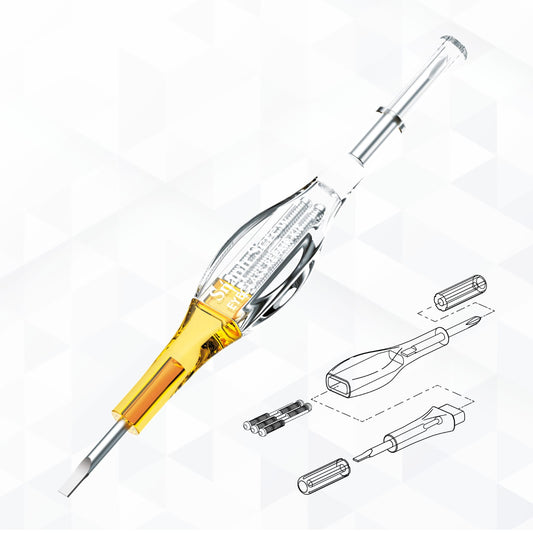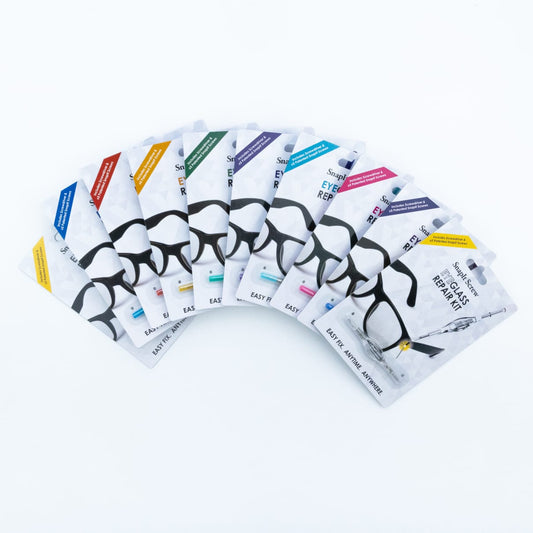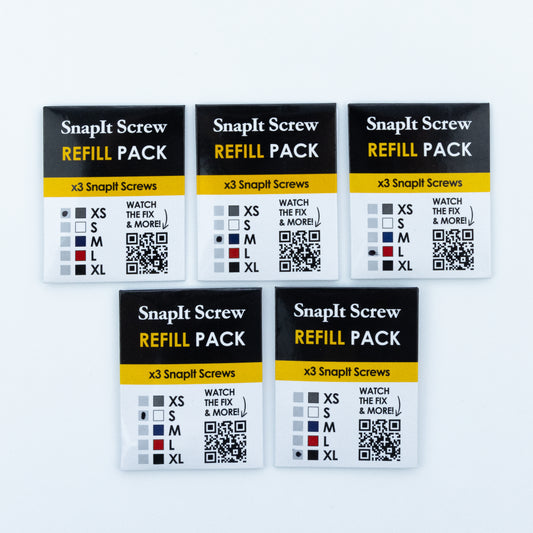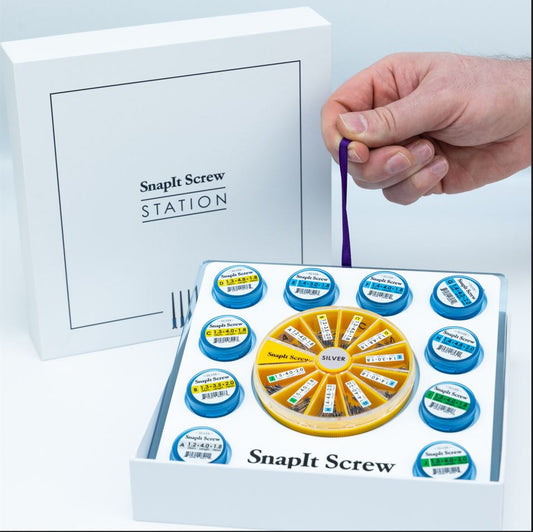Whether you're a DIY enthusiast trying to fix your glasses or just someone who wants to avoid another optician visit, knowing which screws your glasses use can save time, money, and frustration. With sizes like M1.0, M1.2, and M1.4 appearing in your average eyeglasses repair kit, understanding what they mean and how they differ is key. Here's your complete guide to glasses screws, threading, head styles, finishes, and why SnapIt® simplifies it all—for both UK and US shoppers.
What Do M1.0, M1.2, and M1.4 Mean?
The "M" designation stands for metric sizing and is followed by the diameter of the screw shaft in millimeters.
-
M1.0 = 1.0 mm diameter
-
M1.2 = 1.2 mm diameter
-
M1.4 = 1.4 mm diameter
The difference may seem small, but it's crucial. A screw that’s even 0.2 mm too large can crack a frame; one that's too small may not grip at all. Most eyewear uses M1.2 or M1.4 for hinge screws, while nose pads often use M1.0 or M1.2.
Threading and Length
Glasses screws not only differ in diameter but also in thread pitch (spacing between threads) and length. The correct threading ensures the screw locks tightly without stripping. Standard lengths range from 2 mm to 6 mm, with 4 mm being most common. SnapIt® screws come in precise thread counts designed to match factory specs, reducing slippage or cross-threading.
Head Types: Flat vs Dome
-
Flat Head: Sits flush with the hinge or pad arm; less visible and often used on the temple.
-
Dome Head: Rounded top, typically easier to grip and often found on older or vintage frames.
SnapIt® includes both types in its kits, so you're always prepared.
Finish Options: Black, Silver, Gold & More
Screws aren’t just functional—they’re also visible. The finish should match the aesthetic of your frames:
-
Silver: Stainless steel or nickel-coated; very common.
-
Gold: Popular with designer frames.
-
Black: Matches acetate or matte black frames.
How to Choose the Right One
-
Examine the Old Screw: If available, compare it directly.
-
Use a Screw Sizer Card: Some repair kits come with these;
-
Avoid Guessing: Using the wrong screw can damage your frames permanently.
-
Go Universal: SnapIt® screws are engineered to be compatible with most frames, reducing the guesswork.
SnapIt®: One Kit for UK and US Shoppers
The best part? SnapIt® kits are designed with both UK and US standards in mind. Metric and imperial sizing guidance ensures you always know what you're getting. Here’s why it’s a smart buy:
-
Magnetic Tips and Tweezers: No more fumbling.
-
Pre-sorted by Size and Finish: Quickly find what you need.
- Trusted by Opticians: Reliable, professional-quality components.
Common Eyewear Screw Issues and How the Right Size Solves Them
-
Loose Temples: Use M1.2 or M1.4 screws with a snug thread fit.
-
Falling Nose Pads: Typically fixed with M1.0 or M1.2 flat-head screws.
-
Stripped Screws: Replace with correct threading to restore stability.
-
Screw Won't Stay Tight: Try a slightly longer or tighter thread pitch screw from SnapIt®.
Final Thoughts
When it comes to eyeglass repair, size really does matter. The difference between a secure fit and a recurring issue can come down to a fraction of a millimeter. Rather than juggling dozens of mismatched parts, SnapIt® kits streamline the process, offering compatibility and quality in a compact, organized kit. Checkout www.snapitscrew.com
 and
and  WHEN BUY 3 KITS
WHEN BUY 3 KITS






